Fisher Body Number Plate - 1967
[ Preface ] | [ 1964 ] | [ 1965 ] | [ 1966 ] | [ 1967 ] | [ 1968 ] | [ 1969 ] | [ 1970 ] | [ 1971 ] | [ 1972 ]
[ Atlanta ] | [ Baltimore ] | [ Framingham ] | [ Fremont ] | [ Kansas City ] | [ Oshawa ]
Introduction: For quite some time I’ve had an intense interest in Fisher Body Number plates, a.k.a. trim tag, cowl tag, firewall tag, etc. for 1964 through 1972 Chevelles - hereafter referred to as ‘trim tag’ since that seems to be most common moniker for these little jewels. Their diversity, not only between the different years but between the different plants in a given year, has always fascinated me. This page deals only with 1967 Chevelle trim tags.
The fourth model year of the Chevelle, 1967, saw its final assembly production occur at 5 plants in the U.S. - Atlanta, Georgia - Baltimore, Maryland - Framingham, Massachusetts - Fremont, California - and Kansas City, Missouri - plus Oshawa, Ontario in Canada.
I’ll not attempt to decode what each trim code, paint code, and where applicable, group option codes in this series represent. Click on any year's link in the navigation menu at the top of the page and choose the appropriate link on that year's home page where you’ll find links for detailed information for interior, paint, and group option codes.
All research to date indicates that each Fisher Body plant assigned body numbers in sequential order based on the particular Fisher Body style number. This means that a 2-door sedan built immediately after a Malibu convertible would not have sequential body numbers, or even close, since they are different styles. Depending on production numbers of a particular body style number throughout the model year, the above 2-door sedan and Malibu convertible would be vastly different on a given day of assembly but the next 2-door sedan or Malibu convertible would have a sequential body number for that particular style.
The Fisher Body unit number has nothing to do with the vehicle identification number (VIN) assigned by GM at final assembly and if any were to match, it’d be a coincidence.
Fremont is the only U.S. final assembly plant to use a style number for L6 engined Chevelles with an odd 3rd digit in the style designation, all other U.S. plants used an even third digit in the style designation for both L6 and V8 Chevelles.
With that, let's begin 1967.
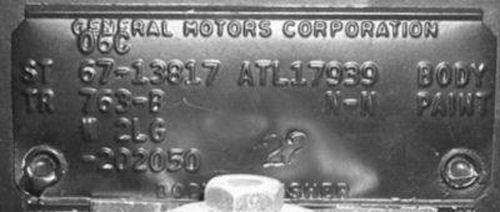
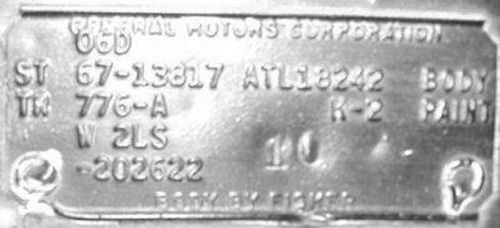
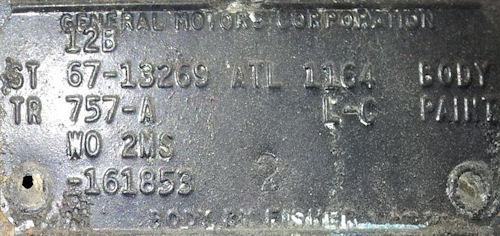

The first information line has the body assembly date consisting of the month as a 2-digit number and a single letter (A…E) designating the week. When the month is a single digit month (January through September) the month number is padded with a leading zero (0) such as 01, 02, 03, etc. This body date is embossed below the GENERAL MOTORS CORPORATION stamping. In the examples 06C is the 6th month (June) and “C” represents the 3rd week and "D" represents the 4th week.
The second information line contains the abbreviation ST (for Style) followed by the model year (67), a hyphen, and the Fisher Body style number. Next is the designation for the plant location, ATL for Atlanta, and the Fisher Body unit number followed by BODY. It should be noted that the Fisher Body style number (13817 for an SS396 sport coupe in the example) has nothing to do with the GM VIN series/model designation. That means the 13817 does not indicate a V8 engine just because the third digit is an even number. Fisher Body at Atlanta did not care if the car was to receive a V8 or L6 engine. Being two examples are SS396 and no L6 SS396 was built, these would naturally be a V8 Chevelle. The third tag is of a 300 4-door sedan and although the style number shows 13269 the VIN is 13169 indicating an L6 engine. Generally, the Fisher Body unit number, 17939 and 18242 in these cases, was sequential for the particular Style number.
The third information line contains the abbreviation TR (for Trim) followed by a 3-digit number, a hyphen, and a letter indicating the seat type and color. The letter "A" indicates a bench seat, the letter "B" indicates a bucket seat, and the letter "S" indicates head rests. Next is a 2-character sequence indicating the exterior paint color with the lower body color represented by the first letter, a hyphen, and the upper body color represented by the second letter, and finally the word PAINT. When the second character is a number, it indicates a vinyl or convertible top color. The second example has the number "2" indicating a black vinyl top.
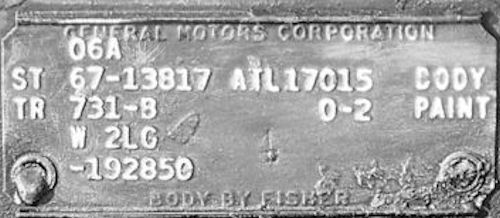
When the paint code position(s) contain a "0" in the first or both locations it indicates the car was ordered with the special paint option. The specific color is not specified by the characters but do indicate that a non-standard color was chosen for the vehicle.
The fourth and fifth (if applicable) information line contains various letters and numbers indicating the various option groups (1 through 5) with a number and letters for various options the car was ordered with within those groups. It should be noted that the first group of options does not have the number “1,” the letter “W” is in the first option group in these examples. The first 3 groups are embossed on the 4th line while it is believed the 4th and 5th groups are found on the 5th line if applicable.
In the examples shown, there is also a hand stamped number (22 and 10 in these examples) that is believed to be a final inspector’s stamp. This 1- or 2-character hand stamped number has been found in various locations on the trim tag so it won’t always be in the same location as the example.
Not everyone is concerned with a reproduction trim tag, but it can provide an insight into the car's build. Here's an example of a (poorly done) reproduction trim tag for Atlanta. Several things wrong with this tag.

* The body date and sequence number (137871) are not compatible.
This VIN sequence is more in line with the 3rd week of December.
* The body number for an SS396 sport coupe (11845) is more in line
with late February.
* Interior trim code and exterior paint code characters are not the
same as the rest of the information.
* Note lack of "slag" covering the rivets. While this "feature"
varied, it's rare to find one from Atlanta with no slag at all
covering the rivets.
* Note there is no hand stamped number that is found on the majority
of 1967 Atlanta trim tags.

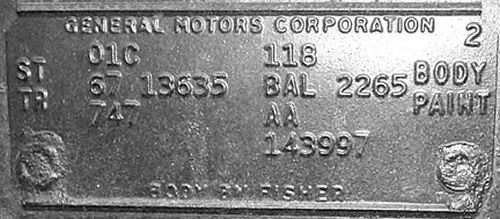
The first information line has the body assembly date consisting of the month as a 2-digit number and a single letter (A…E) designating the week. When the month is a single digit month (January through September) the month number is padded with a leading zero (0) such as 01, 02, 03, etc. Next is a 3-digit number that corresponds to the Job Number found on trim sheet for that car. Lastly, the first line (although found in other locations throughout the model year, most notably the bottom right corner as well) is a single number. It’s believed this number is for the body jig, or gate, the body was assembled on and used for quality control.
The second information line contains the abbreviation ST (for Style), followed by the model year (67) and style number. Next is the designation for the plant location, BAL for Baltimore, and the Fisher Body unit number followed by BODY. It should be noted that the Fisher Body style number (13867 for an SS396 convertible or 13635 for a 4-door Malibu station wagon in the examples) has nothing to do with the GM VIN series/model designation. That means that 13667 or 13635 does not indicate a V8 engine just because the third digit is an even number. Fisher Body at Baltimore did not care if the car was to receive a V8 or L6 engine. Generally, the Fisher Body unit number, 64 and 2265 in these examples, was sequential for the particular STYLE number.
The third information line contains the abbreviation TR (for Trim) followed by a 3-digit number indicating the seat type and color. Note Baltimore did not use -A or -B as some other plants did to differentiate between bench and bucket seats. Next is a 2-character sequence indicating the exterior paint color with the lower body color represented by the first letter and the upper body color represented by the second letter, and finally the word PAINT. If the car has a vinyl or convertible top, the second character in the paint code is a number and designates the top's color as shown in the first example where the "1" represents a white convertible top.
The fourth information line contains a 6-digit number that matches the Identification number found on Baltimore Trim & Body Broadcast Sheets.

Beware of fake trim tags like the one above. Many things wrong with
this one from Baltimore.
** Baltimore does not use group option codes...
** There is no option coded "D" in group 4...
** Baltimore does not separate the lower and upper body color codes
with a hyphen ( - ) character...
** Tag is missing the single- or double-digit number used by Baltimore
in the top or lower right corner...
Unfortunately the owner that send me this had already purchased the
car.
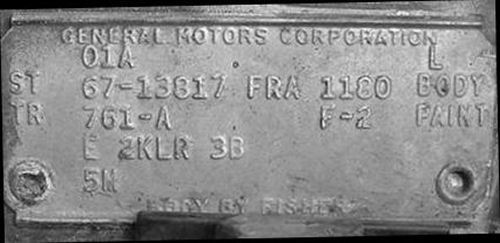
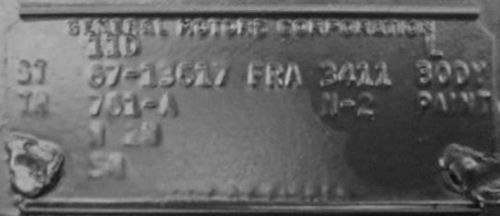
The first information line has the body assembly date consisting of the month as a 2-digit number and a single letter (A…E) designating the week. When the month is a single digit month (January through September) the month number is padded with a leading zero (0) such as 01, 02, 03, etc. This body date is embossed below the GENERAL MOTORS CORPORATION stamping. In the examples, 01A is the 1st month (January) and “A” represents the 1st week. The single letter in the top right corner designates the interior trim paint color.
The second information line contains the abbreviation ST (for Style) followed by the model year (67), a hyphen, and the Fisher Body style number. Next is the designation for the plant location, FRA for Framingham, and the Fisher Body unit number followed by BODY. It should be noted that the Fisher Body style number (13617 for a Malibu sport coupe in the example) has nothing to do with the GM VIN series/model designation. That means the 13617 does not indicate a V8 engine just because the third digit is an even number. Fisher Body at Framingham did not care if the car was to receive a V8 or L6 engine. Being the top example is an SS396 and no L6 SS396 was built, this would naturally be a V8 Chevelle but in the case of the other non-SS396 trim tags, one cannot know from the style number if the car was built with an L6 or V8 engine. Generally, the Fisher Body unit number, 1180 in this case, was sequential for the particular Style number. The 13617 Malibu in the lower photo is a known L6 Malibu with the VIN beginning with 135177G1xxxxx.
The third information line contains the abbreviation TR (for Trim) followed by a 3-digit number, a hyphen (except for the very early trim tags when a hyphen was not used), and a letter indicating the seat type and color. The letter "A" indicates a bench seat, the letter "B" indicates a bucket seat, and the letter "S" indicates head rests. Next is a 2-character sequence indicating the exterior paint color with the lower body color represented by the first letter, a hyphen, and the upper body color represented by the second letter, and finally the word PAINT. When the second character is a number, the number indicates a vinyl or convertible top color. In the above example the number "2" indicates a black vinyl top.
The fourth and fifth (if applicable) information line contains various letters and numbers indicating the various option groups (1 through 5) with a number and letters for various options the car was ordered with within those groups. It should be noted that the first group of options does not have the number “1,” but all other groups are preceded by the numbers "2" through "5." The first 4 groups are embossed on the 4th line while the 5th group may be found on the 5th line.
The "Early" and "Late" designations are my terms and apply to the design of the trim tag itself. The data presented on both formats is essentially the same, just the layout differs. The change is in the representation of the numbers in the lower right corner and this change seems to have occurred during the second week of December.
Early Fremont


The first information line has the body assembly date consisting of the month as a 2-digit number and a single letter (A…E) designating the week. This body date is embossed below the GENERAL MOTORS CORPORATION stamping. In the examples 10A is the 10th month (October) and “A” and "E" represents the 1st week and “E” represents the 5th week.
The second information line contains the abbreviation ST (for Style) followed by the model year (67), a hyphen, and the Fisher Body style number. Next is the designation for the plant location, BF for Fremont, the Fisher Body unit number and the word BODY.
Fremont is the only U.S. plant in 1967 to match the Fisher Body Style
number to the GM series/model designation in the VIN, meaning Fremont
would use a style number such as 13380 to designate an L6 engine in
the car where other plants would use a style number of 13480.
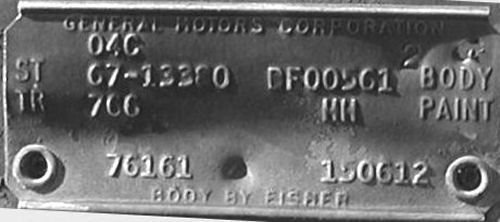
The third information line contains the abbreviation TR (for Trim) followed by a 3-digit number indicating the seat type and color. Next is a 2-character paint code and the word PAINT. If the second character is a number, such as "1" in the first example, this indicates a white convertible or vinyl top.

When the paint code position(s) contain a hyphen character in the first or both locations it indicates the car was ordered with the special paint option. The specific color is not specified by the characters but do indicate that a non-standard color was chosen for the vehicle.
The fourth information line contains the RPO code B90 on Fremont Malibu series El Caminos or the RPO C08 code when the car was equipped with a vinyl top. Otherwise this fourth line is blank.
The fifth information line has a 5-digit number on the left side of the trim tag corresponding to the order number from the dealer's order sheet. The right side of the trim tag has a 2-digit number followed by a 3-digit number. This is the primary difference between "early" and "late" 1967 Fremont trim tags. The source of these numbers is not known yet but it is suspected they are identification numbers found on the Trim Broadcast Sheet or Build sheet.
Hand stamped on the trim tag is often found a 1- or 2-digit number that is believed to be a final inspectors stamping. Whether this was done on the Fisher Body side of the house or the final assembly line is not known at this time. Typically this hand stamped number is found in the upper right corner. Also found on the early formatted Fremont trim tags is what appears to be a single- or double-pointed punch mark on the tag generally on the center of the tag. Whether this is a second final inspection designation or it has some other meaning entirely isn't known but it is present on the majority of 1967 Chevelle trim tags from Fremont.
Late Fremont
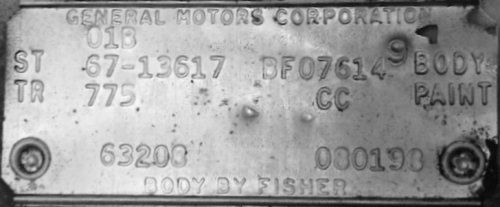

Sometime during the model run in 12B, Fremont made one change to the information embossed on the trim tag. That change is the numbers in the lower right corner. Instead of a 2- and 3-digit number, a single 6-digit number appears.
Kansas City final assembly plant trim tags were fairly straightforward with 4 lines of information and consistent throughout the model year.


The first information line has the body assembly date consisting of the month as a 2-digit number and a single letter (A…E) designating the week. When the month is a single digit month (January through September) the month number is padded with a leading zero (0) such as 01, 02, 03, etc. This body date is embossed below the GENERAL MOTORS CORPORATION stamping. In the examples, 09D is the 9th month (September) and “D” represents the 4th week. The 4-character number is obviously some internal plant tracking code but to date it has not turned up on any paperwork so it's significance is unknown.
The second information line contains the abbreviation ST (for Style) followed by the model year (67), a hyphen and the Fisher Body style number. Next is the designation for the plant location, KAN for Kansas City, and the Fisher Body unit number followed by BODY. It should be noted that the Fisher Body style number (13667 for a Malibu convertible in the example) has nothing to do with the GM VIN series/model designation. That means the 13667 does not indicate a V8 engine just because the third digit is an even number. Fisher Body at Kansas City did not care if the car was to receive a V8 or L6 engine. In this case of style of 13667, one cannot know from the style number if the car was built with an L6 or V8 engine. Generally, the Fisher Body unit number, 233 in this case, was sequential for the particular Style number.
The third information line contains the abbreviation TR (for Trim) followed by a 3-digit number, a hyphen, and a letter indicating the seat type and color. The letter "A" indicates a bench seat, the letter "B" indicates a bucket seat, and the letter "S" indicates head rests. Next is a 2-character sequence indicating the exterior paint color with the lower body color represented by the first letter, a hyphen, and the upper body color represented by the second letter, and finally the word PAINT. When the second character is a number, it indicates a vinyl or convertible top color.
The fourth information line contains various letters and numbers indicating the various option groups (1 through 5) with a number and letters for various options the car was ordered with within those groups. It should be noted that the first group of options does not have the number “1,” but all other groups are preceded by the numbers "2" through "5."
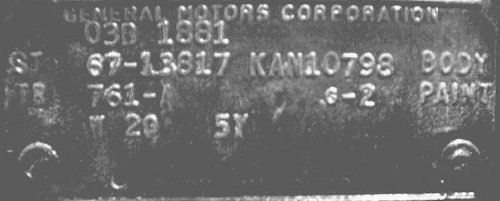
One oddity is sometime between 10D and 11D the paint letter "G" for Granada Gold became a much smaller letter. The reasoning for this is unclear but this continued through the 1968 model year at Kansas City as well. It's not like the letter "G" die was broken and never replaced; note the letter "G" in the 2nd group options, it appears to be a normal size.
Reproduction/Fake Trim Tags



There was a guy making the fake tags that always put 4N or 4K (L78) on his fake Chevelle tags until someone outed a fake car and the news got back to the trim tag guy that those codes were not used on Chevelles, so he stopped doing that recently.
Also notice on the bottom trim tag the letter G code for Granada Gold paint, this letter G was reduced to about half this size early in the model year for Kansas City.
The Oshawa, Ontario plant Style number does indicate whether the car was to have an L6 or V8 engine.

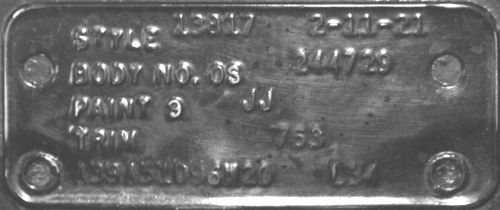
Chevelles built in Canada have trim tags vastly different from their U.S. counterpart and have 5 lines of information.
The first information line has the word STYLE followed by the particular body style designation, 13569 and 13817 on the examples. The XLD on the first example also indicates the car was destined for export outside of Canada or U.S.
Next is the assembly date; 2 is for the second shift (of 2 at the plant), a hyphen, followed by a number for the month, a hyphen, and a number for the day of the month. Since the trim tag went on the car at the start of the assembly cycle and it might take anywhere from 3 to 5 days for a car to complete the assembly process, it's assumed this date is when the car was scheduled to begin assembly, not when it finally rolled off the assembly line.
The second information line has BODY NO. followed by a 6-digit number. It's believed this body number is sequential regardless of the style. It is not known at this time what the starting number might have been.
The third information line has the word PAINT and is followed by a single number indicating enamel or lacquer paint and followed by a 2-character paint code.
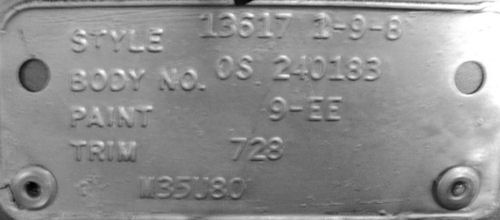
Note this very early model year trim tag has a hyphen between the paint type and color (9-EE)
The fourth information line has the word TRIM and is followed by a 3-digit number indicating the interior trim code.
The fifth information line has any RPO option codes that might be applicable.
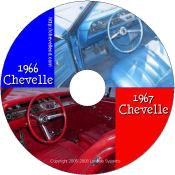
Want more in-depth information and greater analysis on 1966/1967 Chevelles?
Try my
1966/1967 Chevelle
Reference CD.

 Home
Home Decode
Decode Tech
Tech Tools
Tools Dale's Coins/CDs
Dale's Coins/CDs Contact
Contact Chevelle
of the Month
Chevelle
of the Month Things
For Sale
Things
For Sale Custom
Stickers
Custom
Stickers